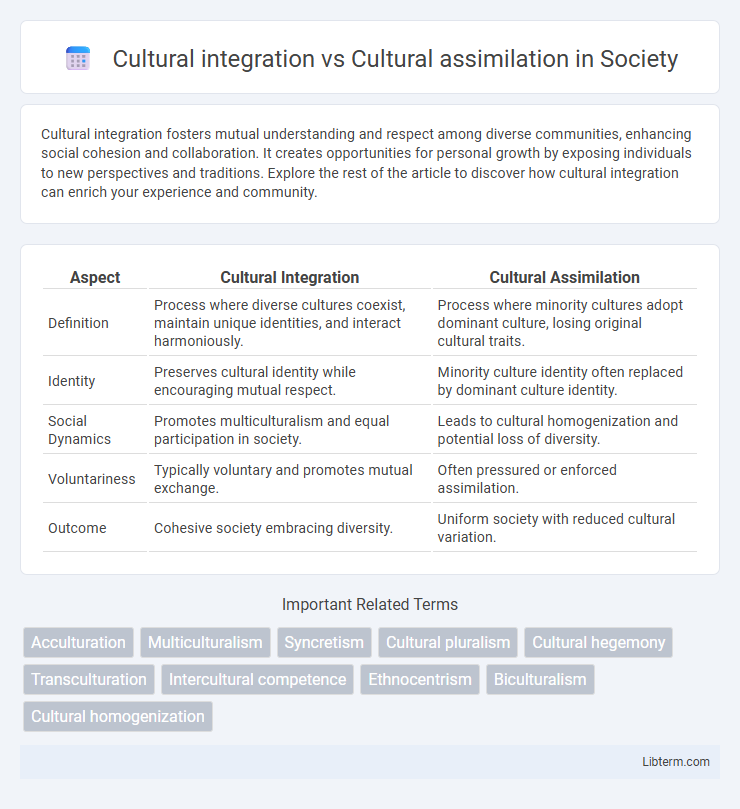Cultural integration fosters mutual understanding and respect among diverse communities, enhancing social cohesion and collaboration. It creates opportunities for personal growth by exposing individuals to new perspectives and traditions. Explore the rest of the article to discover how cultural integration can enrich your experience and community.
Table of Comparison
| Aspect | Cultural Integration | Cultural Assimilation |
|---|---|---|
| Definition | Process where diverse cultures coexist, maintain unique identities, and interact harmoniously. | Process where minority cultures adopt dominant culture, losing original cultural traits. |
| Identity | Preserves cultural identity while encouraging mutual respect. | Minority culture identity often replaced by dominant culture identity. |
| Social Dynamics | Promotes multiculturalism and equal participation in society. | Leads to cultural homogenization and potential loss of diversity. |
| Voluntariness | Typically voluntary and promotes mutual exchange. | Often pressured or enforced assimilation. |
| Outcome | Cohesive society embracing diversity. | Uniform society with reduced cultural variation. |
Introduction to Cultural Integration and Assimilation
Cultural integration involves the process where individuals from different cultural backgrounds maintain their unique identities while participating fully in the social, economic, and political life of the host society. In contrast, cultural assimilation refers to the process by which individuals or groups adopt the dominant culture, often losing distinct cultural traits over time. Understanding these concepts is essential for addressing multiculturalism and fostering inclusive communities in diverse societies.
Defining Cultural Integration
Cultural integration involves blending diverse cultural groups into a society where each group retains its unique identity while participating fully in social, economic, and political life. It emphasizes mutual respect, intercultural dialogue, and coexistence without demanding the loss of original cultural traits. Key characteristics include cultural exchange, accommodation, and the nurturing of a multicultural environment that values diversity.
Defining Cultural Assimilation
Cultural assimilation occurs when individuals or groups adopt the cultural norms, values, and behaviors of another dominant culture, often leading to the loss of their original cultural identity. It involves a unidirectional process where minority cultures conform to the majority culture's language, customs, and social practices. This contrasts with cultural integration, which allows for the coexistence and mutual respect of diverse cultural identities within a society.
Key Differences Between Integration and Assimilation
Cultural integration emphasizes mutual respect and coexistence where individuals maintain their unique cultural identities while participating in a shared society, promoting diversity and inclusion. Cultural assimilation involves one group adopting the dominant culture, often leading to the loss of original cultural traits and identity. The key difference lies in integration supporting cultural plurality, whereas assimilation encourages cultural conformity to a single dominant norm.
Historical Perspectives on Cultural Adaptation
Historical perspectives on cultural adaptation reveal distinct differences between cultural integration and cultural assimilation, with integration allowing diverse groups to maintain unique cultural identities while participating in a shared society. Cultural assimilation often involved dominant groups imposing their values and norms, leading to the erasure of minority cultures, as seen in colonial and migration histories worldwide. Studies of indigenous populations and immigrant communities demonstrate ongoing tensions and negotiations between preserving heritage and adapting to prevailing cultural frameworks.
Social Impacts of Integration versus Assimilation
Cultural integration promotes social cohesion by allowing diverse groups to maintain unique identities while participating equally in society, fostering mutual respect and reducing discrimination. In contrast, cultural assimilation often leads to the loss of minority cultural identities and social alienation, potentially causing psychological stress and weakening community bonds. Integration supports multiculturalism and social inclusion, whereas assimilation pressures conformity, sometimes resulting in social fragmentation and inequality.
Challenges and Benefits of Cultural Integration
Cultural integration facilitates mutual respect and preserves diverse identities while fostering social cohesion, but challenges include potential cultural misunderstandings and resistance to change. It encourages collaboration and innovation by blending different cultural perspectives, enhancing community resilience and economic growth. Addressing language barriers and promoting inclusive policies are essential to overcoming obstacles and maximizing the benefits of cultural integration.
Consequences of Cultural Assimilation
Cultural assimilation often leads to the erosion of original cultural identities, resulting in the loss of languages, traditions, and social norms unique to minority groups. This process can cause psychological distress and a sense of alienation among individuals who feel compelled to abandon their heritage to fit into the dominant society. Furthermore, cultural assimilation may contribute to reduced cultural diversity, weakening the social fabric and limiting the richness of multicultural societies.
Real-World Examples: Successes and Failures
Cultural integration promotes coexistence where diverse groups retain distinct identities while participating equally in society, exemplified by Canada's multicultural policies fostering social cohesion and economic success. In contrast, cultural assimilation, as seen in historical U.S. Native American boarding schools, aimed to eradicate indigenous cultures, resulting in long-term trauma and loss of heritage. Mixed outcomes appear in France's assimilation approach, which struggles with social tensions due to its emphasis on uniform national identity over cultural diversity.
Future Trends in Cultural Adaptation
Future trends in cultural adaptation emphasize a shift from cultural assimilation, which demands full adoption of dominant norms, toward cultural integration that values diversity and mutual respect. Emerging models promote hybrid identities and intercultural dialogue, fostering inclusive societies that leverage multicultural strengths for innovation and social cohesion. Advances in technology and globalization accelerate these trends by enabling cross-cultural communication and collaboration on an unprecedented scale.
Cultural integration Infographic

 libterm.com
libterm.com